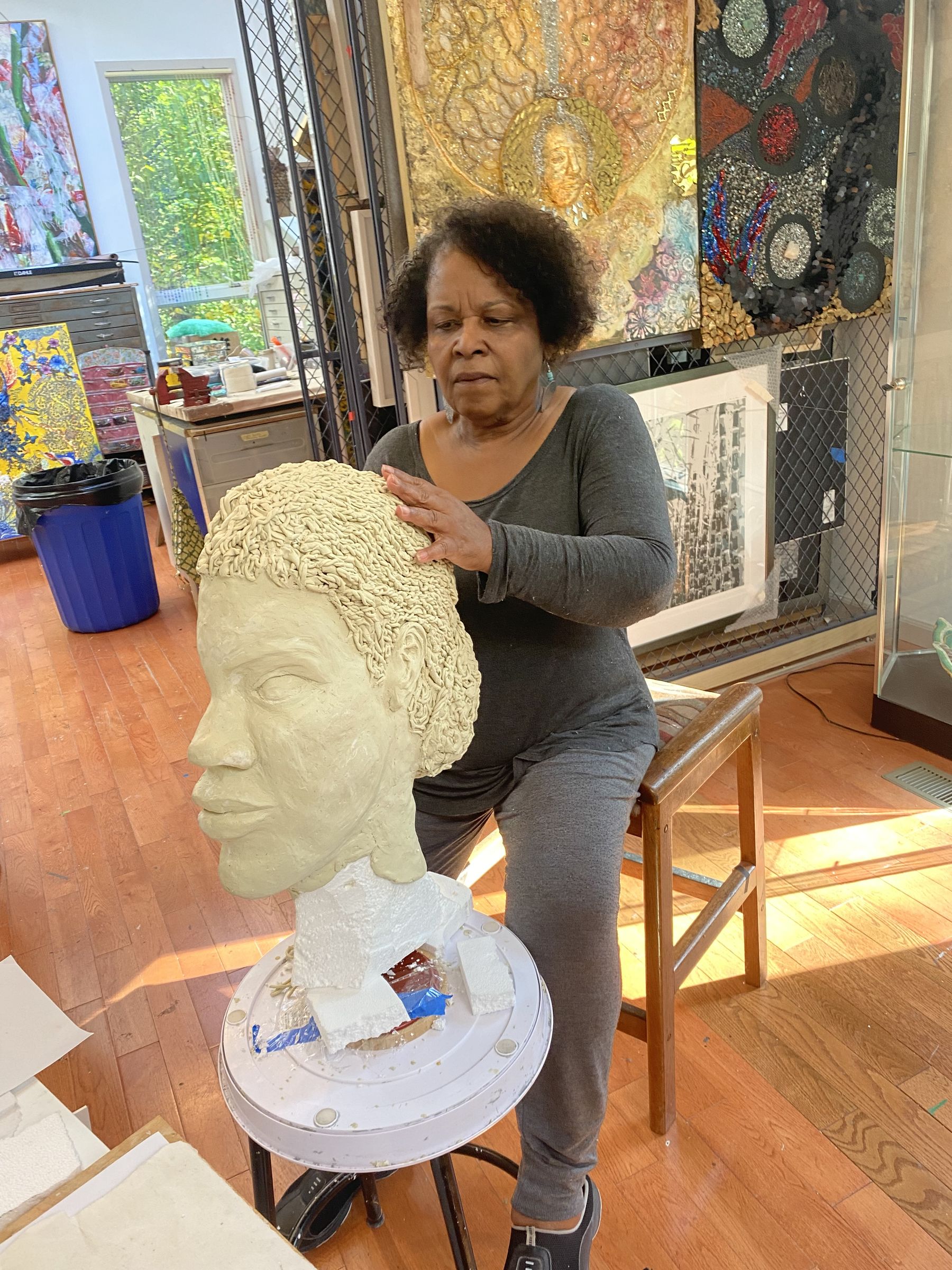The memorial is an outdoor garden space, oval in shape, defined by a low brick wall on which people are welcome to sit and reflect. It was designed to be accessible to McDonogh’s PK to twelfth-grade population and provides an opportunity for people to have real conversations and learn about this period in history.
Ascend Sculpture
Positioned in the center of the garden is a multi-layered sculpture called Ascend. It is approximately 14-feet tall and was forged out of both polished and matte steel by A.R.T. Research Enterprises, an art casting and art fabrication company in Lancaster, PA. It is not only a singular element in the space but something that draws on the environment as well. It is designed to encompass the colors in the garden and landscaping and reflect it back.
- The plinth: the sculpture will be erected on a pedestal that is similar to the platforms on which enslaved people stood during the auctions in the slave market in New Orleans.
- Sugar cane stalks: John McDonogh owned sugar and cotton plantations in Louisiana, and harvesting the sugar cane was brutal work. The stalks were chosen instead of cotton because of their upward motion and the lyricism of the leaves.
- Sweetgum tree: the Sweetgum tree has a history in enslaved communities—it not only represents an obstacle to freedom but was also used for medicinal purposes. Similar to her spirit sculptures, DeVane incorporated beads in the trunk and the branches. When the tree was cast in steel, it picked up the imprint of the beads. The leaves for the sweetgum tree are from a tree on McDonogh’s campus; DeVane made models of five or six leaves for casting which have been welded to the branches.
- Profile portraits: The profiles of a man and a woman near the top of the sculpture represent those who were enslaved. They are in profile mainly because there aren’t many portraits of enslaved Black people in the early 19th century, and the black paper cutouts were a form of portraiture used at that time. One side of each profile is smooth and the other side is three-dimensional to bring the figures to life. Represented are:
- David K. McDonogh, who John McDonogh sent to be educated at Lafayette College. He resisted being sent to Liberia and eventually studied ophthalmology with a doctor at Columbia University in New York. He was the first Black ophthalmologist in the United States. After his death, friends established the David K. McDonogh Memorial Hospital in Harlem.
- Nancy McDonogh was listed in John McDonogh’s documents as a teacher who taught people how to read. She educated the children on the plantation and later in Liberia.
Water Element
Water is used as an element of transcendence and sacred reflections. The water is a reference to the waterways of Louisiana and the transatlantic slave trade from which free and enslaved people from four continents emerged.
The wall inside the garden features water cascading over the engraved names of 95 people enslaved on John McDonogh’s three plantations—Allard, McDonoghville, and St. Gem—at the time of his death. The 118 other names are people who were manumitted by McDonogh to the American Colonization Society colony of Liberia. They sailed aboard the Mariposa in 1842 and the Rebecca in 1859.
Landscaping
In addition to a sweetgum tree, the area will feature a colorful purple plant similar to indigo—a crop from West Africa used for dye that is also planted in the South.
A glass aggregate incorporated in the pathway reflects light and is a reference to sky and water. The sculpture features some polished steel to reflect the landscape and the pathway.
 Oletha DeVane, an expert arts educator, was a faculty member at McDonogh School for 27 years before retiring in 2020. In addition to her work with students, she served as the Upper School Visual Art Department Chair and Director of Tuttle Gallery. A professional artist, her work has been shown in numerous solo and group exhibitions throughout the world, and she has been commissioned to create original artwork by several institutions including The Reginald F. Lewis Museum of Maryland African-American History & Culture and the DC Homewood Museum at Johns Hopkins University. She has exhibited at The Meyerhoff Gallery at MICA, The Corcoran Gallery of Art in DC, and the Baltimore Museum of Art (BMA), where she had a solo exhibition of her spirit sculptures, one of which was recently purchased and placed in the museum's permanent collection.
Oletha DeVane, an expert arts educator, was a faculty member at McDonogh School for 27 years before retiring in 2020. In addition to her work with students, she served as the Upper School Visual Art Department Chair and Director of Tuttle Gallery. A professional artist, her work has been shown in numerous solo and group exhibitions throughout the world, and she has been commissioned to create original artwork by several institutions including The Reginald F. Lewis Museum of Maryland African-American History & Culture and the DC Homewood Museum at Johns Hopkins University. She has exhibited at The Meyerhoff Gallery at MICA, The Corcoran Gallery of Art in DC, and the Baltimore Museum of Art (BMA), where she had a solo exhibition of her spirit sculptures, one of which was recently purchased and placed in the museum's permanent collection. 
.jpg) filmmaker, and writer is the producer of a documentary film about the creation of the memorial to honor the enslaved peoples of John McDonogh. The documentary was premiered following a special dedication of the Memorial during Reunion Weekend 2022.
filmmaker, and writer is the producer of a documentary film about the creation of the memorial to honor the enslaved peoples of John McDonogh. The documentary was premiered following a special dedication of the Memorial during Reunion Weekend 2022.